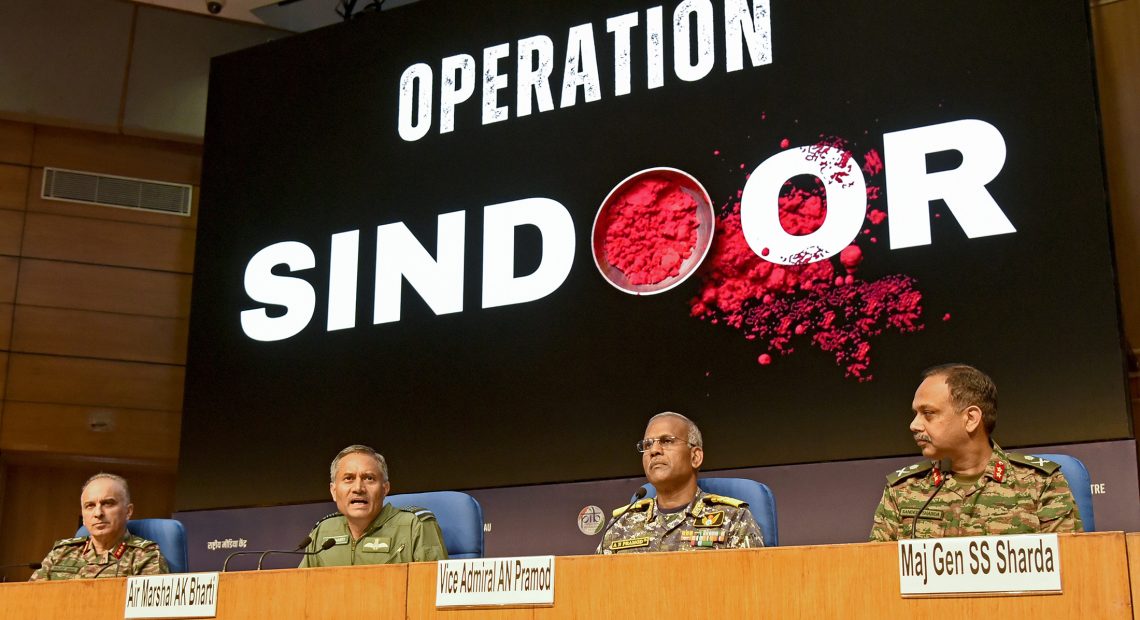
Breaking Down the News: What India’s Military Just Told the World in the Operation Sindoor Briefing
A Press Conference Unlike Any Other
On May 12, 2025, India held an extraordinary tri-service press conference to brief the nation and the world about Operation Sindoor, its retaliatory operation against terrorist infrastructure in Pakistan and Pakistan-occupied Jammu and Kashmir (PoJK). What made this press conference stand out wasn’t just the participation of the top brass from all three services—Army, Air Force, and Navy—but also the unmistakable tone of calm confidence, poetic symbolism, and hard proof.
The speakers were:
- Air Marshal A.K. Bharti, Director General Air Operations
- Lieutenant General Rajiv Ghai, Director General Military Operations
- Vice Admiral A.N. Pramod, Director General Naval Operations
Together, they outlined what India did, why it did it, and how effectively its military systems responded to direct and hybrid threats from across the border.
The Power of Poetry—A Message Wrapped in Verse
The press conference began with lines from renowned Indian poet Ramdhari Singh Dinkar’s “Krishna ki Chetavani”, declaring that India would no longer seek peace with folded hands, but was now prepared for decisive confrontation. This wasn’t just cultural theatre—it was strategic messaging. The day before, the briefing had opened with the powerful Shiv Tandav Stotra, and now, with Dinkar’s verses, the message was loud and clear:
India is done with warnings. It is ready to act.
The DGMO would later elaborate that such verses weren’t just patriotic flair, but reflected India’s evolving military doctrine: a refusal to accept provocation without retaliation.
India’s Fight Was with Terrorism—But Pakistan Got Involved
Air Marshal Bharti emphasized that India’s primary target was terrorist infrastructure in PoJK and deep inside Pakistan. On May 7, India struck only terrorist hideouts, making a deliberate effort to avoid Pakistani military or civilian targets.
However, the Pakistan military chose to step in—not to stop terrorists, but to protect them.
In the Air Marshal’s words:
“It is a pity that the Pakistan military chose to intervene and bat for the terrorists, which compelled us to respond in kind.”
This changed the nature of the engagement. What could have remained a counter-terrorist operation turned into a limited conflict—because Pakistan chose to make it their fight.
India responded with measured precision, maintaining its ethical stance while ensuring overwhelming retaliation against the intervening forces.
What Pakistan Threw at India—and What Happened to It
The briefing offered a rare level of transparency about what the enemy used and how India responded.
Among the weapons Pakistan used:
- PL-15 air-to-air missiles (Chinese origin): Fired but missed their targets. The debris was recovered by India and displayed.
- Long-range artillery rockets: Attempted to target Indian installations but were intercepted.
- Bayraktar TB2 drones (Turkish origin): These famed drones, known from the Armenia-Azerbaijan conflict and the Ukraine war, were shot down.
- Other drones and loitering munitions: A mix of surveillance and combat UAVs, including kamikaze drones, were brought down mid-air by Indian systems.
Each piece of wreckage was shown to the media—parts of missiles, drone rotors, even undercarriage frames.
The Indian Defence Systems That Held the Line
In stark contrast to Pakistan’s foreign-supplied arsenal, India relied on a combination of vintage systems, indigenous innovations, and real-time coordination across services. Air Marshal Bharti detailed how India’s multi-layered air defence system worked:
From shoulder-fired MANPADS to short- and medium-range surface-to-air missiles, to radar-guided long-range interceptors, India had deployed a net so dense that no enemy missile, drone, or aircraft could break through.
Key Indian systems mentioned or implied included:
-
Akash SAM (Surface-to-Air Missile) – Indigenous and highly effective against aerial threats
-
Pechora and OSA-AK – Old but reliable Soviet-era systems, still operational and combat-ready
-
Low-Level Air Defence (LLAD) Guns – Used for close-range threats like drones
-
Indigenous Counter-UAS Systems – Electronic and kinetic systems developed in India to destroy hostile drones
-
Integrated Space Command and Control System (ISCCS) – A net-centric coordination framework connecting all defence assets in real time
What stood out was India’s ability to combine old and new, showing that even vintage weapons, when maintained and integrated smartly, can outperform modern but misused systems like the PL-15 or Bayraktar TB2.
The Navy’s Role—Locking Down the Sea
Vice Admiral A.N. Pramod outlined how the Indian Navy ensured maritime dominance during Operation Sindoor. The deployment of India’s Carrier Battle Group, complete with MiG-29K fighter jets and AEW (Airborne Early Warning) helicopters, created an impenetrable defensive zone at sea.
No hostile aircraft could approach the fleet—even within several hundred kilometers. Any attempt by Pakistani aerial units to move towards India’s maritime assets was blocked preemptively.
This presence didn’t just protect Indian naval interests—it forced Pakistan’s air elements to remain confined to areas near the Makran coast, unable to support operations elsewhere.
As the Vice Admiral stated with unambiguous clarity:
“Should we choose to, we can strike at will.”
The Army’s Grid—Every Layer Built to Kill
Lieutenant General Rajiv Ghai walked the media through India’s layered land-based air defence grid, coordinated closely with the Air Force and supported by the BSF. He compared the grid to the 1970s Ashes cricket series, invoking the proverb:
“Ashes to ashes, dust to dust, if Thommo don’t get ya, Lillee must.”
His point was simple but chilling: even if a threat managed to penetrate one layer of defence, it would be brought down by another. This wasn’t just rhetoric—the visual slides displayed radar positions, engagement points, and weapon impact zones.
The DGMO credited:
-
BSF soldiers on the border for using counter-drone tech
-
Army gun crews for swift response
-
Air Defence Command for synchronizing all layers into one lethal grid
Evidence vs Propaganda — India Shows, Pakistan Hides
Throughout the briefing, Indian officers presented photographic and video evidence of the strikes they carried out. These included:
-
Satellite images of destroyed targets
-
Videos showing post-strike craters (e.g., at Rahim Yar Khan Airfield)
-
Recovered debris of enemy weapons systems
In contrast, Pakistan’s DG ISPR held a press conference the previous day but offered no evidence—no photos, no videos, not even coherent responses to the known damage at Pakistani military sites.
DGMO Rajiv Ghai addressed this contrast sharply:
“We don’t do PR. We act, and we prove.”
He reaffirmed that India’s strikes were precisely targeted at terrorists, not civilians or the Pakistan military—unless they intervened, which in this case, they did.
When asked whether Pakistan was using propaganda to calm domestic anger, the DGMO declined to speculate—but made it clear India had no interest in playing narrative games. It had done its job, and the proof was in the field.
Did India Hit Nuclear Facilities? The Answer is Sarcastic—and Telling
One journalist asked whether India had struck the Kirana Hills facility in Sargodha—rumored to be a Pakistani nuclear storage site. The DGMO responded with biting sarcasm:
“Thank you for informing us that Kirana Hills houses nuclear infrastructure—we didn’t know that.”
He then clarified that India did not target Kirana Hills or any nuclear-related facilities, directly or indirectly.
The subtext? India has the capability to do so, and perhaps they did it but they won’t foolishly admit it in public.
What This Means for the Region—and for India’s Defence Industry
Operation Sindoor doesn’t just mark a military milestone—it’s a watershed moment for India’s defence credibility.
Here’s why:
-
India neutralized PL-15 missiles, Bayraktar drones, and other Chinese/Turkish weapons—all of which China’s neighbors are worried about
-
Systems like the Akash SAM and indigenous counter-drone platforms are now battle-proven
-
Countries like Vietnam, Philippines, Armenia, Egypt, and Indonesia are already in talks to buy these systems
-
India has demonstrated that it can defend against threats many nations fear—but can do so with indigenously developed and affordable platforms
This gives India a unique diplomatic and commercial edge: it’s the only country so far to publicly show that Chinese and Turkish combat systems can be defeated in real battle, not just theory.
A Nation Ready—With Its People Behind It
In closing, the DGMO thanked India’s 140 crore citizens, crediting them for their prayers, unity, and support.
“When resolve is strong, even the destination bows at your feet.”
All three officers confirmed that India’s military systems remain fully operational and ready for any future missions. Not one system went offline. Not one base was breached.
India did not go to war lightly. But when forced to act, it did so decisively, precisely, and unapologetically.


















